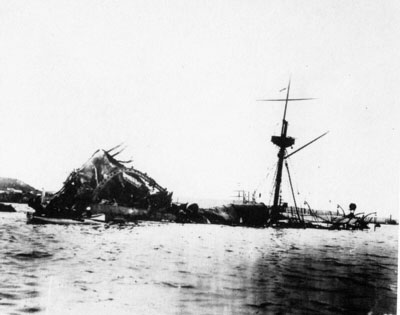USS Maine (ACR-1), commissioned in 1895, was the first United States Navy ship to be named after the state of Maine. Originally classified as an armored cruiser, she was built in response to the Brazilian battleship Riachuelo and the increase of naval forces in Latin America. Maine and her near-sister ship Texas reflected the latest European naval developments, with the layout of her main armament resembling that of the British ironclad Inflexible and comparable Italian ships. Her two gun turrets were staggered en échelon, rather than on the centerline, with the fore gun sponsoned out on the starboard side of the ship and the aft gun on the port side, with cutaways in the superstructure to allow both to fire ahead, astern or across her deck. She dispensed with full masts thanks to the increased reliability of steam engines by the time of her construction.

Despite these advances, Maine was out of date by the time she entered service, due to her protracted construction period and changes in the role of ships of her type, naval tactics and technology.The general use of steel in warship construction precluded the use of ramming without danger to the attacking vessel. The potential for blast damage from firing end on or cross-deck discouraged en échelon gun placement. The changing role of the armored cruiser from a small, heavily armored substitute for the battleship to a fast, lightly armored commerce raider also hastened her obsolescence. Despite these disadvantages, Maine was seen as an advance in American warship design.
Maine is best known for her loss in Havana Harbor on the evening of 15 February 1898. Sent to protect U.S. interests during the Cuban revolt against Spain, she exploded suddenly, without warning, and sank quickly, killing nearly three quarters of her crew. The cause and responsibility for her sinking remained unclear after a board of inquiry investigated. Nevertheless, popular opinion in the U.S., fanned by inflammatory articles printed in the “Yellow Press” by William Randolph Hearst and Joseph Pulitzer, blamed Spain. The phrase, “remember the Maine, to Hell with Spain”, became a rallying cry for action, which came with the Spanish–American War later that year. While the sinking of Maine was not a direct cause for action, it served as a catalyst, accelerating the approach to a diplomatic impasse between the U.S. and Spain.
The cause of Maine‘s sinking remains a subject of speculation. In 1898, an investigation of the explosion was carried out by a naval board appointed under the McKinley Administration. The consensus of the board was that Maine was destroyed by an external explosion from a mine. However, the validity of this investigation has been challenged. George W. Melville, a chief engineer in the Navy proposed that a more likely cause for the sinking was from a magazine explosion within the vessel. The Navy’s leading ordnance expert, Philip R. Alger took this theory further by suggesting that the magazines were ignited by a spontaneous fire in a coal bunker.The coal used in Maine was bituminous coal, which is known for releasing firedamp, a gas that is prone to spontaneous explosions.There is stronger evidence that the explosion of Maine was caused by an internal coal fire which ignited the magazines. This was a likely cause of the explosion, rather than the initial hypothesis of a mine.
